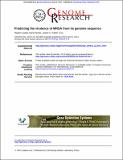Predicting the virulence of MRSA from its genome sequence
Abstract
Microbial virulence is a complex and often multifactorial phenotype, intricately linked to a pathogen's evolutionary trajectory. Toxicity, the ability to destroy host cell membranes, and adhesion, the ability to adhere to human tissues, are the major virulence factors of many bacterial pathogens, including Staphylococcus aureus. Here, we assayed the toxicity and adhesiveness of 90 MRSA (methicillin resistant S. aureus) isolates and found that while there was remarkably little variation in adhesion, toxicity varied by over an order of magnitude between isolates, suggesting different evolutionary selection pressures acting on these two traits. We performed a genome-wide association study (GWAS) and identified a large number of loci, as well as a putative network of epistatically interacting loci, that significantly associated with toxicity. Despite this apparent complexity in toxicity regulation, a predictive model based on a set of significant single nucleotide polymorphisms (SNPs) and insertion and deletions events (indels) showed a high degree of accuracy in predicting an isolate's toxicity solely from the genetic signature at these sites. Our results thus highlight the potential of using sequence data to determine clinically relevant parameters and have further implications for understanding the microbial virulence of this opportunistic pathogen.
Citation
Laabei , M , Recker , M , Rudkin , J K , Aldeljawi , M , Gulay , Z , Sloan , T J , Williams , P , Endres , J L , Bayles , K W , Fey , P D , Yajjala , V K , Widhelm , T , Hawkins , E , Lewis , K , Parfett , S , Scowen , L , Peacock , S J , Holden , M , Wilson , D , Read , T D , van den Elsen , J , Priest , N K , Feil , E J , Hurst , L D , Josefsson , E & Massey , R C 2014 , ' Predicting the virulence of MRSA from its genome sequence ' , Genome Research , vol. 24 , pp. 839-849 . https://doi.org/10.1101/gr.165415.113
Publication
Genome Research
Status
Peer reviewed
ISSN
1088-9051Type
Journal article
Description
This work is supported by the EC-FP7 program no. 245500 and the BBSRCCollections
Items in the St Andrews Research Repository are protected by copyright, with all rights reserved, unless otherwise indicated.

